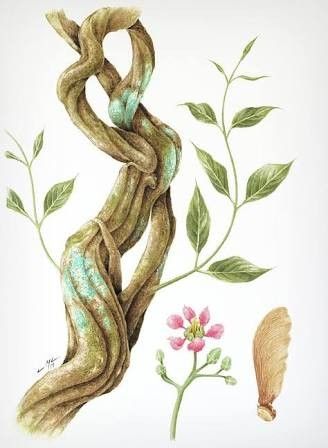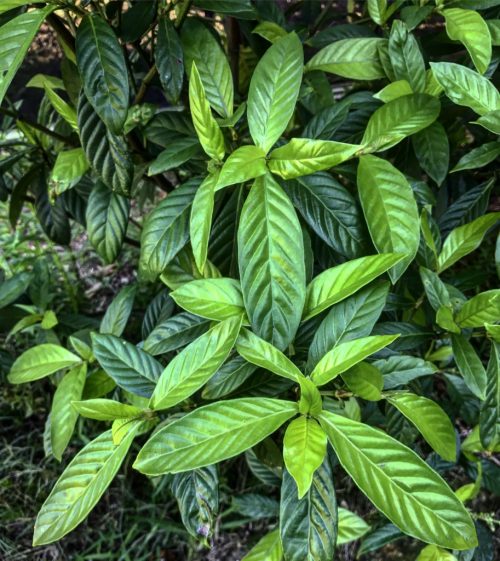
By Erik Hendrick
August, 2023
Botanical and psychopharmacological aspects
The Amazonian brew known as Ayahuasca is prepared using mainly two plants requiring a long cooking process. One of these plants is a liana (Banisteriopsis caapi) whose best-known and most widespread name is, precisely: ayahuasca. It grows in the Amazon jungle, particularly in the tropical forests of Peru, Brazil, Colombia, Ecuador, Bolivia, and Venezuela. The other plant used is a bush known by the name chacruna (Psichotria viridis) and it is the plant that contains the psychoactive component called N,N-dimethyltryptamine (DMT). The Ayahuasca liana is the one that contributes to the brew the monoamine oxidase inhibitors (MAOI), the B-carbolines, especially harmine and tetrahydroharmine. Aminooxidase is an enzyme found in the digestive system and its function in the body is to break down the DMT that enters the digestive system. The MAOI's contained in ayahuasca block the degradation process of DMT, which allows the psychoactive action of DMT to finally be triggered. It is known that the mixture of these two chemical elements is responsible for the visionary effects of this ancient sacred drink. Shipibo healers mainly use these two plants in their ayahuasca brew preparation; However, among the different native peoples of the Amazon there are different ways of preparing ayahuasca, adding different plants and varying the proportions of cooking. As mentioned, enzymes called monoamine oxidases (MAO) have the function of degrading certain neurotransmitters that have already fulfilled their function in the body, for example, they degrade serotonin (5-hydroxytryptamine or 5HT), whose molecular structure is extremely similar to that of DMT. On the other hand, it is known that DMT is a molecule that the human organism synthesizes naturally, and scientists affirm that its function is related to the production of dreams. DMT is thought to be produced in the pineal gland, known in the mystical realm as the third eye. In addition, it is thought that there is a close relationship between the DMT produced by the pineal gland and visionary or ecstatic states.
Anthropological and historical aspects

Rope of death would be the proper translation for Ayahuasca, a word from the Runasimi language or Quechua language. This liana is the main ingredient for the preparation of a drink that until today is used by different peoples of the Amazon; such as: the Shipibo people, the Ashaninka, the Shuar, the Amahuacas, the Lamas, the Huachipaire, among many others. In the stories of the original peoples of the Amazon, for example in the mythical stories of the Ashaninka that are transmitted orally generation after generation, it is told how the rituals and the sacred and medicinal use of Ayahuasca were taught by the wise Inca warriors. It is known that the Incas occupied different regions that are currently occupied by different peoples who still use Ayahuasca, and that they carried out cultural exchanges with different peoples of the jungle. The presence of the culture and worldview of the Inca people inside the jungle is undeniable. Federico Kauffman Doig, cited by Soria (1995), reports that during the Spanish conquest, the Inca warriors fled into the jungle, some settled in the vicinity of the Huallaga river and formed the Chazuta town and others continued advancing through the Huallaga and the Ucayali to the border with Brazil. For this reason, some peoples, such as the Shipibo and the Ashaninka, believe that the Inca is their father, and their myths speak of the father and sun god and of the return of the Incas. It is also known that cultural exchanges between the Andean civilization and the peoples of the Amazon take place centuries before the height of the Inca culture.
No one knows precisely how long ago the Ayahuasca brew has been used, but it seems that it is a tradition that is thousands of years old, from the time when ceramics have been used in the Amazon jungle, because to obtain the brew it is required a long cooking process. The history of the Andean and Amazonian peoples is essentially a mythical story. The use of the ayahuasca concoction spread to almost all the towns of the Amazon, and it continues to be the most important religious magical drink to this day.
Contemporary use
Currently, the traditional knowledge and uses of ayahuasca practiced by Amazonian native communities are considered as cultural heritage of the Peruvian nation, and nowadays, psychologists and doctors in Peru are working to achieve an integration between the ancestral knowledge of the Andean culture and Amazon and contemporary psychotherapy. However, most research and studies on Ayahuasca are carried out by researchers from other countries. Research on Ayahuasca is very extensive, and is carried out from anthropology, ethnobotany, neurology, psychology, among other disciplines.
Today ayahuasca is known throughout the world, and it is no longer only used by the peoples of the Amazon. For almost a century it has been part of syncretic religions in Brazil, and for two decades the mystical tourism of Ayahuasca has expanded vertiginously, so that today it is extremely easy to run into many shamans who are not really shamans and who are travelling around the world providing their services. For this reason, those who seek an authentic experience with Ayahuasca must be very careful in their search and encounter with this ancient brew. There is an irresponsible and commercial use of Ayahuasca, in addition to deceit and immorality on the part of many pseudo-shamans.
Ayahuasca is called grandmother, mother, mermaid, princess and teacher, and is considered by the mestizo shamans of the jungle as a power plant and a powerful purge. In the jungle of Peru, the concoction is used by healers and sorcerers in their magic and enchantment rituals, in spells and in spiritual combat between shamans. There are shamans who use the concoction and offer their services in large cities such as Iquitos, Pucallpa and Lima. And the majority of Peruvian residents see only this picturesque aspect of Ayahuasca, they see it as a drug used by shamans and sorcerers, dangerous and alien to their lifestyles. Although due to the interest that Ayahuasca has aroused worldwide, regarding its religious, medicinal, therapeutic and spiritual qualities, there are currently also people in Peru with a great interest in knowing in depth this ancient brew and its medicinal and spiritual virtues. . In the Amazon jungle, in Lima, in Cusco and in other places in Peru, there are Retreat Centers that use Ayahuasca, although not all do so under exactly the same approach, there is interest, on the part of some retreat centers, to integrate the practices of the original peoples of the Amazon, wisdom traditions and therapeutic methods. In some retreat centers the work with ayahuasca is carried out with commitment, seriousness and vocation, and also, with a certain methodological rigor; but there are also many places that use Ayahuasca from an inconsistent and incongruous New Age perspective.

Psychotherapeutic aspect
It is very likely that the name rope of death or Ayahuasca has arisen due to the states of consciousness to which the person who ingests this sacred potion is taken. This sacred drink gives access to states of mind that allow experiencing a parallel dimension of reality, a non-material but fully existing world, a dimension that we can call the spiritual world of ayahuasca. In depth psychology this world is known as the world of psychic reality or the archetypal world. Many people who participate in Ayahuasca sessions report the sensation of dying, some even claim to have experienced death itself. There are those who experience this state of death with fear and terror, but there are those who describe this state as an experience of absolute peace and total surrender. Apparently, in some cases, the death experience is the prelude to an experience of spiritual rebirth or renewal, and also contact with the world of spiritual beings and realities. On this journey that takes you through death and the world of spirits, it is advisable to be accompanied by a guide and to be able to return from this journey cleaner, healthier, with more clarity, more strength and more wisdom. The guide is commonly known by the word Shaman or shaman.
For thousands of years, here and around the world, the role played by the shaman has been and is, the intermediary between the world of spiritual beings and the ordinary world of physical and material senses. Ayahuasca is a key element in the life of the guide or shaman, since it allows him to enter the other world and bring knowledge and wisdom from this other world, in order to help his people and whoever needs it.
Ayahuasca is entering the life of contemporary civilization, as a medicine capable of healing the sufferings of the human soul, a medicine capable of offering a transformative and life-changing experience, and that can help overcome traumas, complexes, and existential crises. In the life of the cities, many people suffer from the ills of modern, consumerist and materialistic civilization, many suffer emotional and psychological disorders, or mental illnesses, depressions and obsessions, anxiety and anguish, neurosis and psychosis. And there are those who desperately seek relief and cure for their ills, which are ills of the human soul, ills of the spirit. But how can ayahuasca help heal these ills? Much effort has been made in this regard over the last two decades. There is great interest in integrating traditional indigenous medicine and the medicine of contemporary civilization, although integration is often made difficult due to ethnocentrism and cultural resistance. However, a type of Ayahuasca Therapy is emerging that, on the one hand, addresses the therapeutic aspects, and on the other hand, takes into account the spiritual aspect, although from a transpersonal and transcultural perspective or approach, and for this, it is of much help as a frame of reference, humanistic psychology and psycho-spiritual therapies.
Thus, Ayahuasca constitutes the main element in Ayahuasca retreats or in Ayahuasca Therapy, but the effectiveness of Ayahuasca therapy will also depend on the integrity, knowledge, capacity and authenticity of the guide of the therapeutic process. Research shows that the long-term positive effects of the use of Ayahuasca for therapy depend on an adequate process of interpretation, assimilation and integration of the experiences in Ayahuasca sessions.